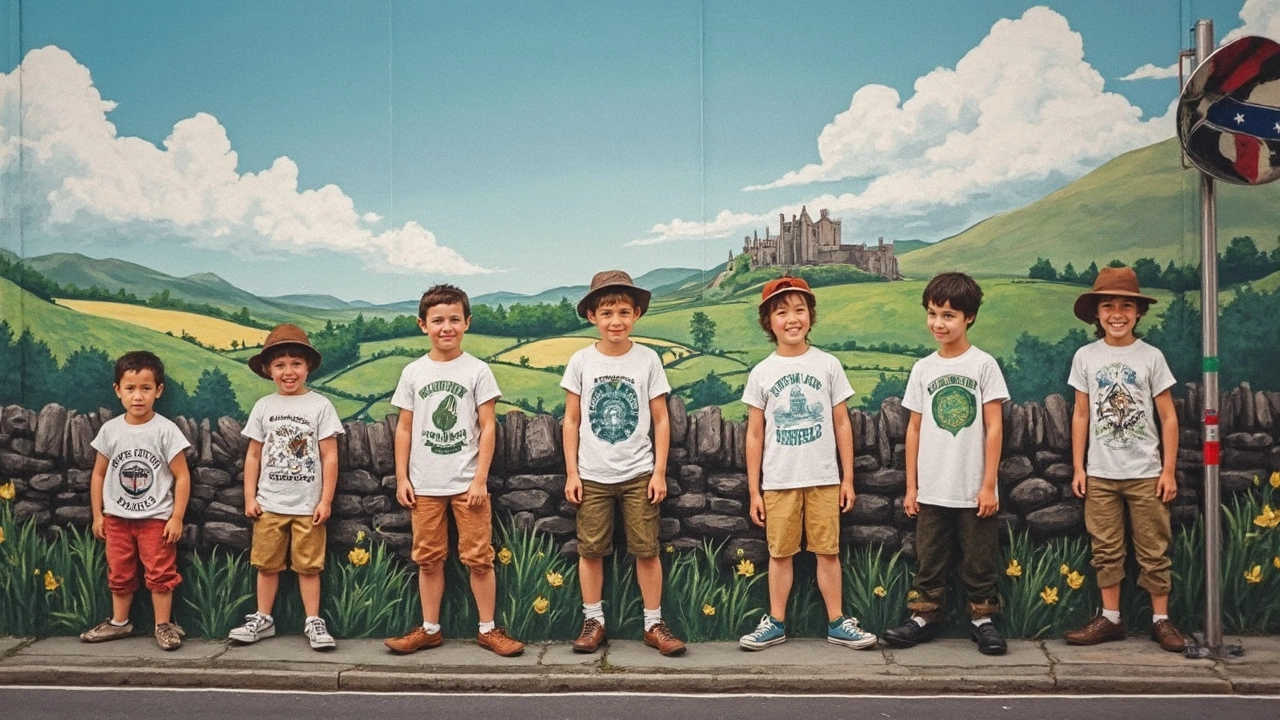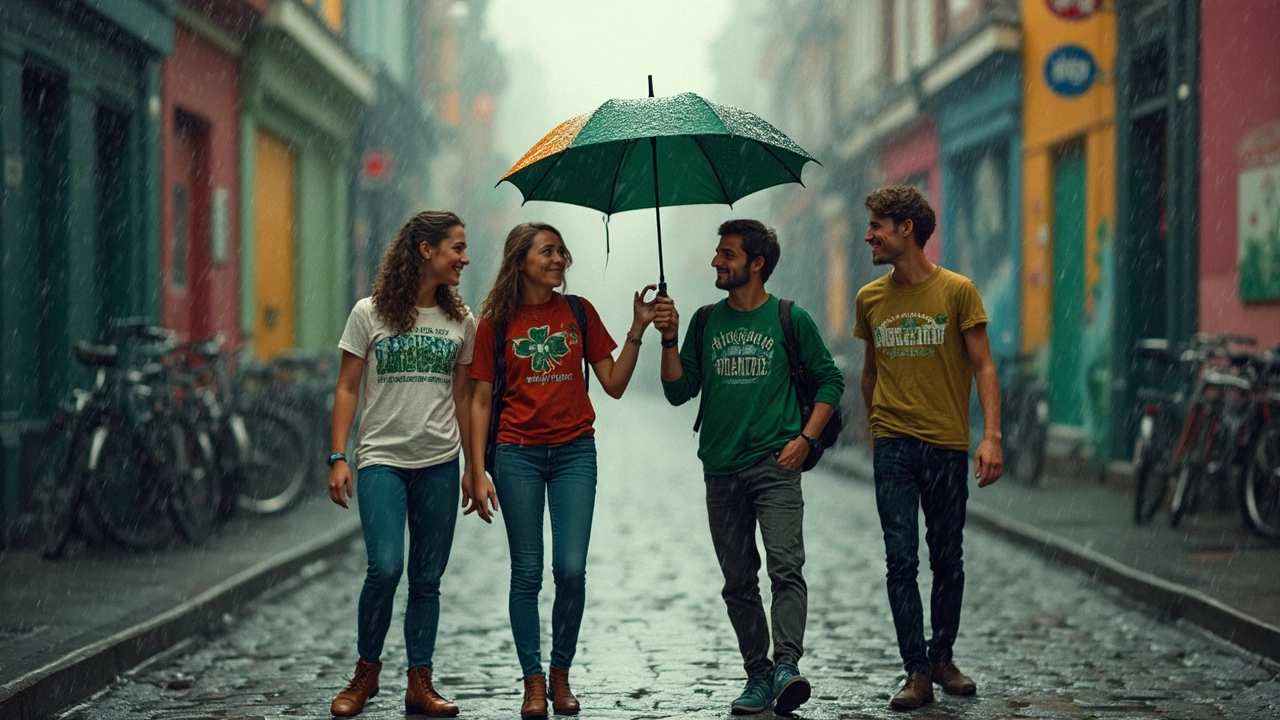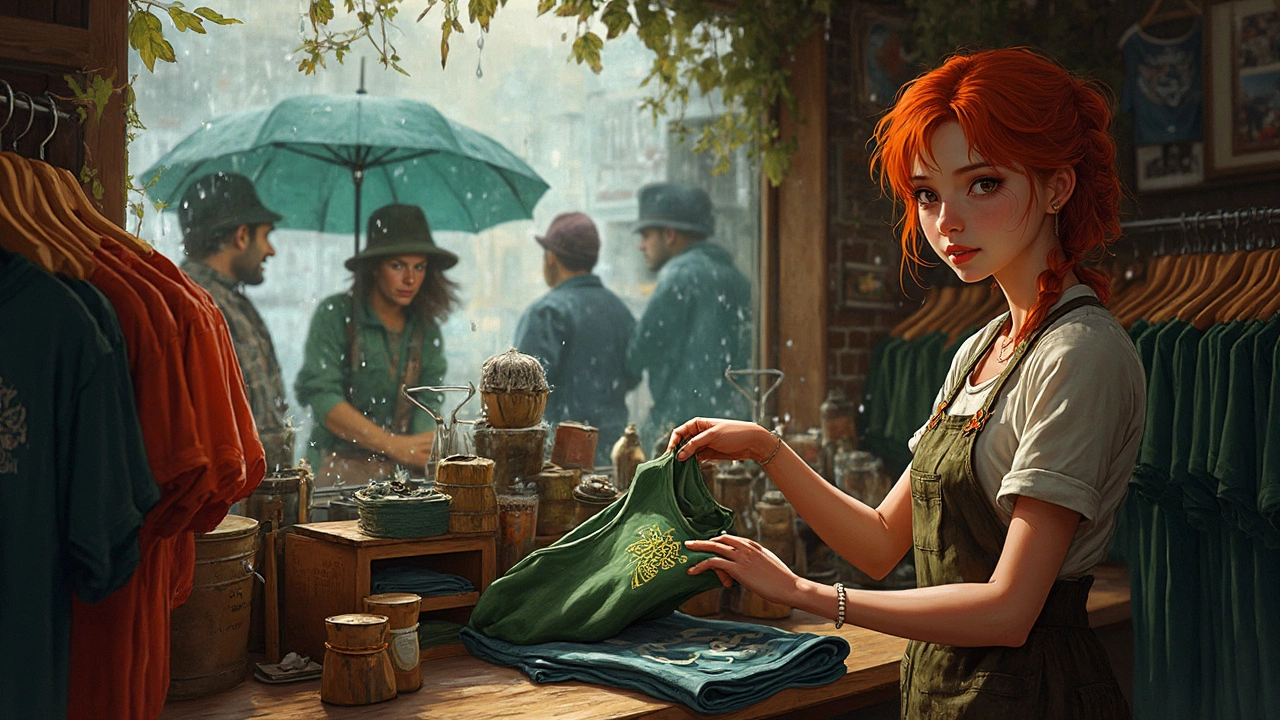Walk down any high street in Ireland and you’re bound to spot T-shirts hanging both in trendy boutiques in Dublin and in the smaller, family-owned shops out west. They’re everywhere, from Cork city centre to Galway’s Shop Street. But here’s a question: why do we actually call it a ‘T-shirt’? Is it just one of those names we all accept, or is there a bit of a story here?
Turns out, it’s a bit of both. The most obvious reason—once someone points it out, of course—is right there in the shape. Lay a T-shirt flat on your kitchen table and the outline is a dead ringer for the letter ‘T’. Simple and almost too obvious, but most of us probably never stopped to think about it. The name stuck and made its way around the world, including right here in Ireland, where tees have become as much a part of daily life as a cuppa at eleven.
- How the T-Shirt Got Its Name
- When T-Shirts Landed in Ireland
- Irish Brands and Local Favourites
- Tips for T-Shirt Care in Irish Weather
- Fun Facts and Irish T-Shirt Trends
How the T-Shirt Got Its Name
The answer to why we call it a T-shirt is honestly straightforward—the shape does all the talking. Stretch a T-shirt out flat, arms spread, and it forms a capital T. No surprise there, but interestingly, this simple design is exactly why people started calling it a T-shirt back in the early 20th century. It was easy to remember and described the garment perfectly.
The roots of the T-shirt go back to the American military. In the 1910s, the U.S. Navy handed out short-sleeved, cotton undershirts to keep sailors cool and comfortable. Soldiers who returned to Ireland after fighting alongside the British pulled the style into everyday wear. Even by the 1950s, Irish lads were still more used to vests and collared shirts, but it wasn’t long before the name ‘T-shirt’ and the practical cut caught on everywhere from Belfast to Kerry.
The Oxford English Dictionary’s first written mention of “T-shirt” was in 1920. And just so you know, Cobh and Cork still claim to have some of the oldest Irish clothiers stocking T-shirts, right from the early days. The garment’s popularity skyrocketed after Hollywood celebrities started sporting them in the 1950s, but the name stuck for its plain logic.
| Fact | Details |
|---|---|
| First U.S. military use | 1913 (Navy undershirts) |
| First print mention | 1920 (Oxford English Dictionary) |
| Popular in Ireland | 1950s onward |
Today, when you buy a T-shirt in Ireland, you’re actually picking up a bit of history. That three-letter name is used everywhere from Grafton Street’s fashion chains to the stalls in Temple Bar. Simple, catchy, and, let’s be honest, so much easier to say than “short-sleeved cotton undershirt.”
When T-Shirts Landed in Ireland
T-shirts were a late bloomer in the Irish clothing scene. Back around the 1950s, you wouldn’t catch many lads in Dublin or Galway strolling around in T-shirts unless they were working on a farm or painting a gable wall. The first T-shirts made it over with American soldiers during World War II, leaving the Irish scratching their heads at these plain undershirts. It took a while, but word caught on, and by the 1960s, T-shirts were popping up in Irish markets, helped along by Hollywood stars like James Dean and Marlon Brando gracing cinema screens in their iconic tees.
By the 1970s, T-shirts started showing up at music festivals like the iconic Féile, and suddenly they were everywhere. Irish teens would get their hands on band T-shirts imported from the UK or US, even if that meant queuing outside Golden Discs on Grafton Street or raiding shops in Cork for any hint of trend. In those days, a T-shirt with a band logo was almost a political statement, especially during the punk and rock years.
Now, the T-shirt is the Irish go-to for layering under jumpers, wearing to gigs, or packing along for that always-unpredictable Wicklow hike. You’re just as likely to see a tee supporting an Irish cause—think Repeal, GAA clubs, or even a nod to Father Ted—as you are a plain white classic. T-shirts have woven into the Irish story, linking fashion to music, sport, and even politics.
- 1950s: T-shirts drift in, mostly as work gear or US imports.
- 1960s: Hollywood and pop culture make them popular for young Irish folks.
- 1970s-80s: Music, youth culture, and sporting pride put Irish T-shirts on the map.
Now you’ll find custom tees made by Cork’s own Hairy Baby, cheeky slogans from Galway’s Treebark Store, and sustainable Irish cotton popping up at Dublin’s D8 stores. In Ireland, the T-shirt isn’t just a basic—it's a talking point, a souvenir, and a bit of social commentary all rolled into one.

Irish Brands and Local Favourites
Anyone living in Ireland knows there’s no shortage of homegrown T-shirt talent. Forget mass-produced stuff you see in airport gift shops; these days, Irish brands are putting the focus on quality, bold design, and a bit of Irish wit. Whether you’re looking for something to wear to a festival in Stradbally, or just need a few reliable basics for work and the gym, plenty of local names have stepped up to fill that gap.
Brands like T-shirt Company Ireland in Galway, Hairy Baby in Cork, and Human Collective in Dublin have built a loyal following. Hairy Baby, for example, started out making quirky tees celebrating Irish humour—think slogans from Father Ted or local sayings you’d only hear on a bus in Limerick. Human Collective, on the other hand, leans into social change and sustainability, using organic cotton and donating to community causes. Even fashion staples like Bewley & Burke or Tropic Ice are catching on with locals looking for reliable, well-made tees that don’t break the bank.
If you’re buying for comfort and want to keep it Irish-made, you’ll spot these brands at markets like the Dublin Flea or pop-ups during the Galway International Arts Festival. For custom options, Irish companies like The T-Shirt Company let you print up your own design—handy for sports teams, hen nights, or those hectic family reunions in Connemara.
Have a look at how some favourites stack up:
| Brand | Main Focus | Based In | Price Range (€) |
|---|---|---|---|
| Hairy Baby | Humour, Irish pop culture | Cork | 20–35 |
| Human Collective | Sustainability, social causes | Dublin | 30–45 |
| The T-shirt Company | Custom printing | Galway/Dublin | 15–35 |
| Tropic Ice | Basics, everyday wear | Dublin | 12–25 |
There’s nothing wrong with grabbing a classic Penneys (Primark) tee either—hard to beat for the price, especially if you’re kitting out a whole family. But if you want something that shows a bit of personality, local brands have you covered. Watch out for limited edition collabs and seasonal designs, especially around St. Patrick’s Day or big GAA matches—these tend to sell out fast.
Your biggest challenge? Narrowing it down to just one or two that you actually need.
Tips for T-Shirt Care in Irish Weather
If you’ve tried line-drying your T-shirts in the Irish drizzle, you know the struggle. With our famous mix of clouds, sun, and rain all in one afternoon, keeping your T-shirt looking and feeling right isn’t always simple. Here’s what actually works for folks living in Ireland.
- Don’t let them sit damp: If you get caught in a shower (common enough), throw your T-shirt into the wash or over a radiator as soon as you’re home. Letting it sit damp encourages musty smells.
- Quick-dry tricks: Not everyone has space for a tumble dryer. Spread your T-shirt flat on an indoor drying rack near a window or, if you’re tight on space, hang it on a hanger on the shower rail. Blow a fan on them for faster drying—surprisingly effective!
- Wash cool, dry gently: Irish Water recommends lower temps (30°C) for washing; it’s better for colours and cuts down on electricity costs. Hot water and hot dryer settings can break down the fibres faster, especially with budget tees from Penneys or Dunnes Stores.
- Keep the shape: Always reshape damp T-shirts before leaving them to dry. Don’t twist or wring them. If you notice saggy shoulders, lay them flat instead of hanging so gravity doesn’t stretch them.
- Spill rescue: Guinness, curry, or ketchup—Irish T-shirts see it all. Blot spills fast with cold water, and dab a bit of washing-up liquid before the full wash. Most stains come out if you act quick.
| Drying Method | Average Time |
|---|---|
| On Radiator | 2–3 hours |
| Drying Rack (near window) | 5–7 hours |
| Tumble Dryer | 45–60 minutes |
| Outdoor Line (dry day) | 3–4 hours |
Lastly, you don’t need fancy sprays or expensive gadgets. Regular washing, quick drying, and a bit of sun (when you can nab it) will keep your favourite tees fresh, whether you’re braving the rain in Limerick or soaking up a rare sunny spell in Wexford.

Fun Facts and Irish T-Shirt Trends
You might think a T-shirt is just another piece of kit in your drawer, but there’s loads of quirky stuff tied up with them, especially in Ireland. First off, did you know the T-shirt didn’t even exist in Ireland before the 1960s as a piece of daily wear? Before that, Irish folks were all about wool jumpers and button-downs. T-shirts were almost exotic, popping up first among American tourists spilling out of buses along the Ring of Kerry.
Today, Irish T-shirt designs show off local humour and pride—think cheeky sayings like “It’s Grand” or “Go on, go on, go on,” made famous by Mrs. Doyle from Father Ted. Every year, around St. Patrick’s Day, shops in Temple Bar and Grafton Street get packed with tees showing off shamrocks, Gaelic slogans, and even county crests. They make for handy souvenirs and Irish people abroad spot them instantly at any airport.
Want something more personal? Look up Irish labels like Hairy Baby, TShock, or Derry Nice Things. They do everything from GAA jokes to retro county maps, and they print in small batches so you’re not likely to spot someone in the same tee at Electric Picnic or the Galway Oyster Festival.
Here’s a handy list of what’s trending with T-shirts in Ireland right now:
- Sustainable cotton: Irish shoppers are on the hunt for organic cotton tees from Irish-owned shops—Ethical clothing is getting big, especially with students in university towns.
- DIY Screen Printing: More community workshops are popping up in Dublin and Cork where you can bring your own artwork or slogans and print them on blank tees.
- GAA and local pride designs: From county colours to club logos, these show up everywhere in summer, especially during the All-Ireland Championships.
- Reworked vintage: Secondhand finds from Irish charity shops get personalised with iron-on patches and stitched slogans. It’s popular among younger crowds looking for a one-off style.
A final fun bit—there’s even a world record for the most T-shirts worn at once, and yes, an Irish lad named Ciaran from Dundalk attempted it in 2017, squeezing into over 240 T-shirts for a fundraiser. So, if you thought we kept it simple with T-shirts here, there’s actually plenty to it. Next time you slip one on, see if it’s a bit of Irish style or humour that sparked your choice.
